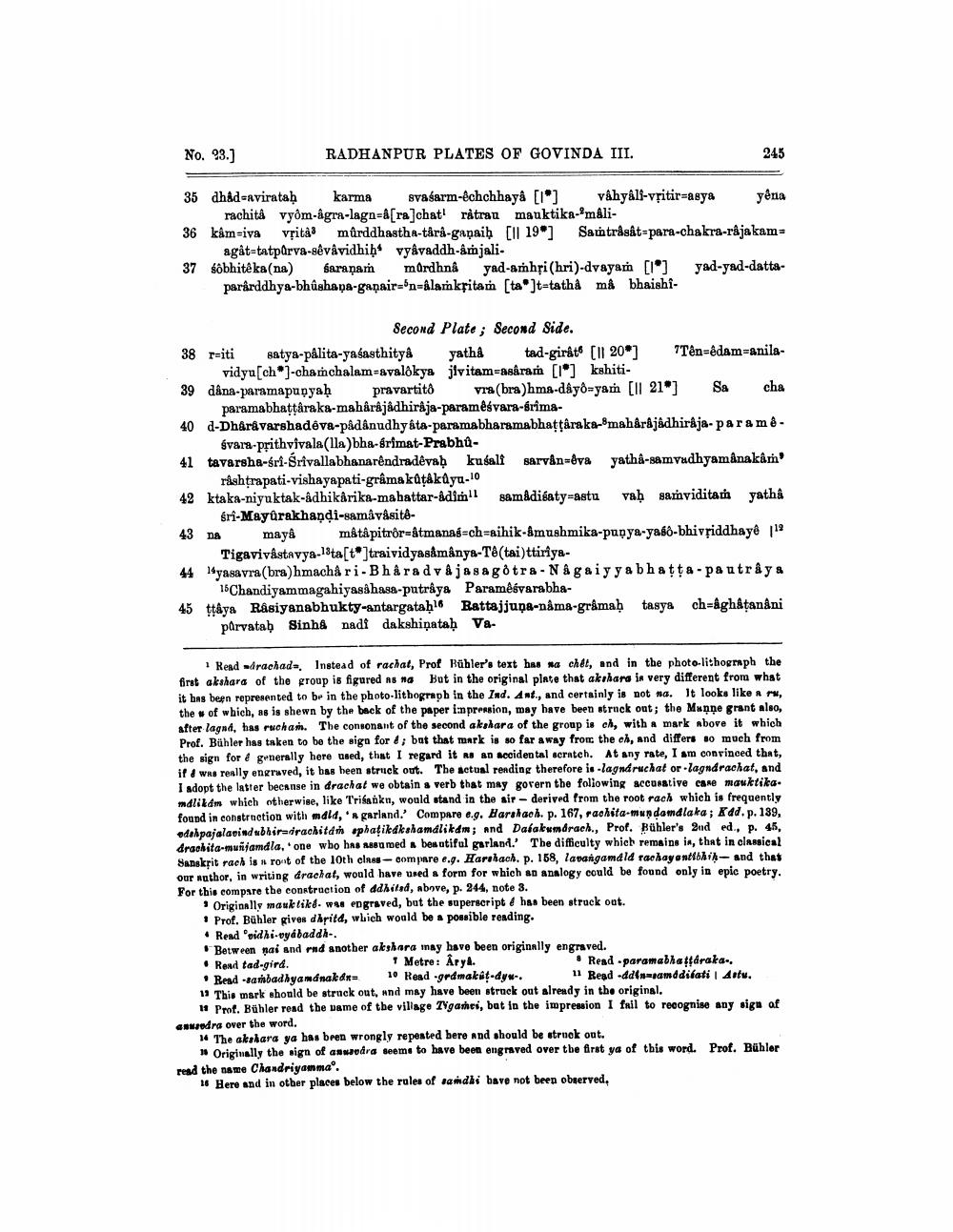________________
No. 23.]
RADHANPUR PLATES OF GOVINDA III.
245
35 dhad-avirataḥ karma svašarm-êchchhayâ [*) váhyalf-vritir=asya yêna
rachita vyðmagra-lagn=a[ra]chat råtran mauktika-mali36 kam-iva vritas mûrddhasthn-tari-ganaih (il 19°] Samtråsât-para-chakra-rajakam
agåttatparva-sêvåvidhib. vyavaddh-Amjali. 37 sôbhitêka(na) Saranam mardhn& yad-amhri (hri)-dvayar [1] yad-yad-datta
parårddhya-bhúshaya-ganair="n=alamkritam [ta]t-tatha må bhaishi
Second Plate; Second Side. 38 rriti satya-pålita-yaśasthitya yatha tad-girátó (ll 20) Tên=edam=anila
vidya[ch]-chamchalam=&valokya jivitam-asarath [1] kehiti39 dåna-paramapapyaḥ pravartit8 vra (bra)hma-dâyð=yam [ll 21"] Sa cha
paramabhattaraka-maharajadhiraja-paramèsvara-grima40 d-Dhåråvarshadêva-pådânudhyâta-paramabharamabhattâraka-maharajadhiraja-parame
Svara-prithvivala(lla)bha-grimat-Prabhu41 tavarsha-sri-Árivallabhanarendradêvab kusali sarv&n=8va yatha-samvadhyamânakâm'
rashtrapati-vishayapati-grâmakatakayu.10 42 ktaka-niyuktak-adhikarika-mahattar-Adin'l samadišaty-astu vah samviditam yatha
sri-Mayurakhandi-samavåsite - 43 na may måtâpitrôr=&tmanag=ch=aihik-&mushmika-puộya-yabô-bhivșiddhayê 112
Tigavivastavya-18ta[t]traividyasåmânya-Te(tai)ttiriya44 4yasayra(bra)hmachå ri-Bharad v & jasagotra-N & g&iy ya bhatta-p&utraya
16 Chandiyammagahiyasi hasa-putraya Paramêsvarabha45 ttaya Råsiyanabhukty-antargataḥ Rattajjuna-nama-gråmah tasya ch=åghatanani
parvatab Sinha nadi dakshiņataḥ Va
Read drachada. Instead of rachat, Prof Rūbler's text has sa chét, and in the photo-lithograph the first akshare of the group is figured as no But in the original plate that akshans is very different from what it has been represented to be in the photo-lithograph in the Ind. Ant., and certainly is not na. It looks like a nu, the w of which, as is shewn by the back of the paper impression, may have been struck out; the Munne grant aleo, after lagnd, has ruchan. The consonant of the second akshara of the group is ch, with a mark above it which Prof. Bühler has taken to be the siga ford; but that mark is so far away from the ch, and differs so much from the sign for é generally here used, that I regard it as an accidental scratch. At any rate, I am convinced that, it was really engraved, it has been struck out. The actual rending therefore is-lagndruchat or lagndrachat, and I adopt the latter becanse in drachat we obtain a verb that may gorern the following accusative care mouktika. mdlikám which otherwise, like Tribankn, would stand in the air - derived from the root rach which is frequently found in construction with mold, ' s garland. Compare e.g. Harshaob. p. 167, rachita-mun damdlaka; Kdd. p. 189, odakpajalapindubhiradrachitdth sphafikdkakamalikdm; and Dalakwadrach., Prof. Bühler's 2nd ed., p. 45, drachita-murijamdla, one wbo has 1889 med a beautiful garland. The difficulty which remains in, that in classical Sanskrit rach is ront of the 10th class - compare e.g. Harshach. p. 158, lavangamdld rachay antibih- and that our nathor, in writing drachat, would have used a form for which so analogy could be found only in epic poetry. For this compare the construction of dahilad, above, p. 244, note 3.
• Originally mauktiks. was engraved, but the superscript & has been struck out.
Prof. Bühler gives dhşitd, which would be a possible reading. • Read oidhi-nyábaddk.
Between wai and end another akshara may have been originally engraved. • Read tad-gird.
Metre: Arya.
• Read.paramabhaftáraka, . Read - sambadhyamának dx= 10 Read .grdmakat-dyw. 11 Read .dd4n-ramddifati | Antu. 11 This mark should be struck out, and may have been struck out already in the original.
11 Prof. Bühler rond the name of the village TVgasri, but in the impression I fail to recognise any sign of causedra over the word.
14 The akılara ya has been wrongly repeated bere and should be struck out.
* Originally the sign of asusodra seems to have been engraved over the first ya of this word. Prof. Bühler read the name Chandriyamma'.
16 Here and in other places below the rules of sandki bave not been observed,




